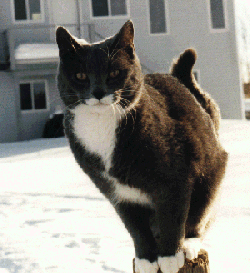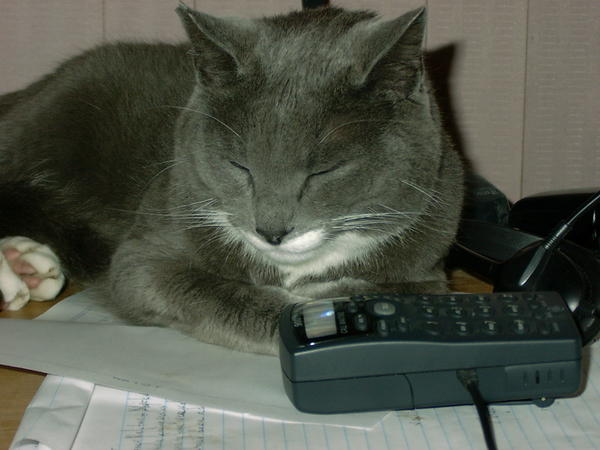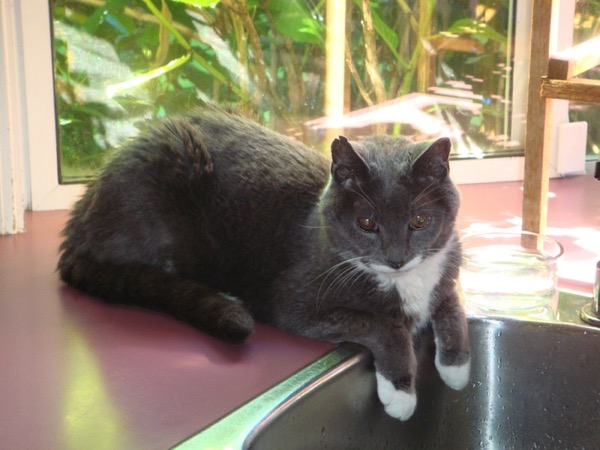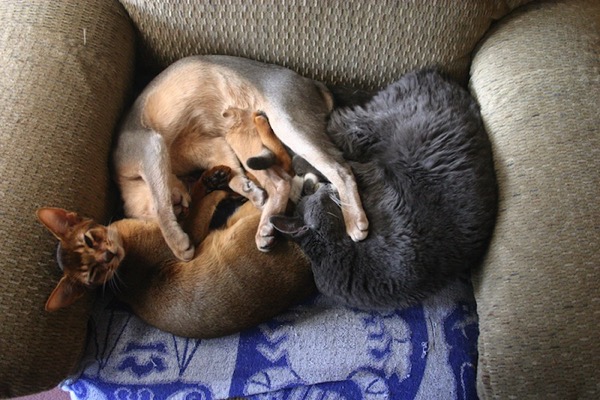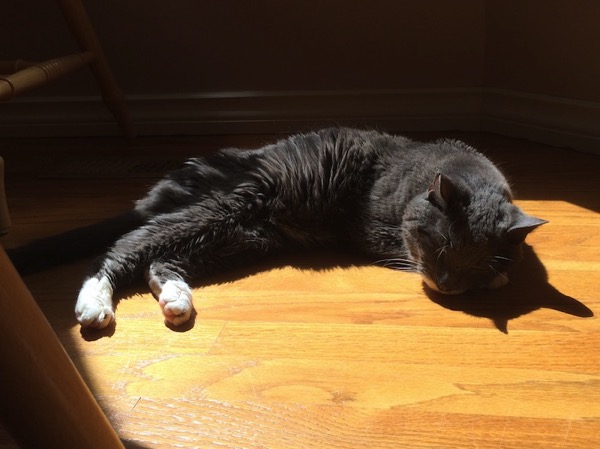I lost a dear friend on Wednesday, November 5. We lived under the same roof for over two decades, and the fact that he wore fur and occasionally killed and ate rodents in his youth did nothing to detract from our bond. I’m talking about my cat, Tuxedo.
The Spring
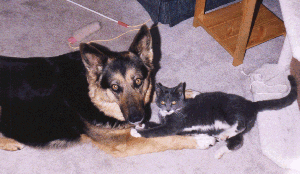
I first met Tuxedo when he was six months old, and I was thirty. Irene and I had been living on our acreage East of Sherwood Park for a couple of years, and decided it was time to add to our furry family. We went to the SPCA in Edmonton, and Irene had already picked out a funny-looking, emaciated female cat who had recently given birth (Sasha). I was still wandering about, and walked past several cat kennels when I felt a tug on my arm. A small grey and white paw was reaching out between the bars and had caught my shirt: I looked in this child-cat’s eyes and couldn’t walk away. I unlocked the bars of the cage and took him in my arms, and that was that. Tuxedo, née Sylvester, was mine, and I was his.
There is some debate in our household regarding whether we adopted Tuxedo in the October of 1994, or April of 1995. Either way, he was born in 1994, and to say we met 20 years ago is sufficiently accurate at this point.
Tuxedo wasn’t noisy, or pushy, or needy, or aggressive- but he was always interested. He wanted to know what we were watching on TV, what I was reading, what my computer was for, where I was going, and when I was coming back. He would follow both Irene and I around as we went about the house and, as we were letting our cats explore the outside in those days, when we went outside. Above all, he wanted to be involved in everything we were doing. And he got along very well with our other cats, particularly with Bilbo, our male Siamese.
He grew up with our dog, Sheena, and never had any particular fear of dogs for his entire life. I remember Sheena used to play with Tuxedo, occasionally putting her jaw around his head: Sheena was exceedingly gentle, but even so it surprised me that not only did Tux tolerate it, he actively sought this kind of play out. And Tuxedo would use Sheena as something of a bodyguard when they were outside together: if another neighbourhood cat was chasing him, he’d run to Sheena, who would just stand there and look somewhat confused. The intruder cats would generally evaporate at that point: Sheena wasn’t aggressive, but 50 pounds of dog still looks pretty scary to most cats.
Doom 2 was released when Tuxedo was still a kitten, and he would watch me playing it with great interest. Late one night when I was playing, Tuxedo took up a position slightly to one side of my monitor, seemingly aware that he shouldn’t get in my line of sight, and started watching the game play particularly closely. After a few minutes, he started batting at the enemies as I shot them, and continued to do this for some time. He would periodically rejoin me in just this fashion, “helping” me fight the demons that infested the levels of Doom. I jokingly gave Tux a second name as a result: Doom Kitty.
The Summer
Tuxedo learned to be a skilled hunter on our acreage, and developed as a lithe, agile cat as a result. He also seemed to have a tremendous ability to avoid getting into trouble, despite wandering over a large area that included grassy fields and trees that were home to coyotes, foxes, and deer as well as the mice and shrews he regularly decimated. He learned to get along well with our horses, our neighbours, and the continuing stream of cats that joined our household.
Tuxedo was never exceedingly friendly when we brought a new cat home: that was Bilbo’s job, who generally was the first of our cats to befriend a newcomer. But Tux was also not mean or intolerant, and he genuinely grew to be good friends with several of our additions over the years. Mogwai and Ember, our “possibly purebred” Abyssinians that we adopted and lost (Ember quite literally walked off and never came back, Mogwai who succumbed to a genetic defect) over the course of a year. Whisper, who we nursed back to health after Irene found her locked in a horse stall only to lose her due to numerous birth defects when she was not even a year old. And finally (in this phase of our life) Willow and Rommel, who settled in for the long haul.
I remember one winter not long after Rommel had reached his adulthood as the “winter of the ear tag”. First Rommel returned home with two deep slashes in his ear that left a single permanent notch. A short time later, Bilbo achieved a similar effect, I believe via a bit of frostbite. And finally Tuxedo, who I swear felt he was losing his machismo now that his male companions had proper war wounds, returned one day not with one notch in his ear but two. I’m sure it was all purely coincidence, but it was odd that none of these three cats ever achieved permanent ear injuries again. I guess ear tears had gone out of style after that one season.
This long summer of Tuxedo’s life, filled with hunting, exploring a vast (to him) expanse of fields and trees, and building a stable “family” of cats, humans, horses and dogs, did not last forever. I had grown tired by 1999 of the continual travel from our Edmonton office, and it had become clear that if I wanted less travel I could move to Toronto, Calgary, or Vancouver. I took an opportunity to move to British Columbia as the better choice, especially since I had family there. The acreage had been good to us, but change is sometimes even better- or so I told myself.
So it was that, in September of 2000, we packed up seven cats into one van and I started the drive out to our new home in Cloverdale, B.C.
The Fall
Anyone who loves their cats should one day try loading seven of them into a van and driving over a thousand kilometres. At the time, we had seven cats: Jagar, Bilbo, Susu, Sasha, Tuxedo, Willow, and Rommel. Irene and I had fitted that rented cargo van out royally for the cats: it had cat trees, litter boxes, food and water, beds and blankets. And most notably, since I was going to be driving the van while Irene and my sister Connie travelled in a car, I had a mesh barricade to keep the cats and myself separate. I needed to keep myself undistracted to drive safely, I theorized, and having unruly cats running around all over me as I drove would be a bad idea.
So instead of having cats climbing all over me, I had cats howling at the top of their lungs on the other side of the barricade, banging against it, trying to squeeze through it, and generally being incredibly… you guessed it… distracting. Bilbo was the worst of them all: the others either took it in stride (Tuxedo) or calmed down after the first few minutes. Bilbo spent the entire trip banging his head against the mesh and howling. He actually (we discovered later) permanently scarred the bridge of his nose trying to squeeze through the mesh. And eventually we had to transfer him to the car with Irene and Connie.
Tuxedo, on the other hand, calmly assessed the situation. I drove, distracted by the screaming and banging of Bilbo, while Tux examined the mesh, found the weakness in this carefully installed obstacle, and managed to bypass it. One moment he was in the back of the van, the next he was sitting beside me, looking out the window, like he had been there all along. Somehow no one else found the same weakness. And Tux remained calm, sitting quietly beside me, for the remainder of the trip.
In a similar calm, thoughtful way, Tuxedo adapted to his new home. We had decided early on that we couldn’t safely let our country-raised cats wander in our new heavily trafficked suburban neighbourhood. We had an enclosed “outdoors” cat run built attached to our house, so the cats could feel the breeze, sounds, and scents of the outside while still being safe. Tuxedo, in response, learned a new skill: stealthy escapes.
Any time the door to the outside was opened, Tuxedo would be somewhere nearby, lurking: waiting for a moment of distraction when he could make his exit. Once outside, he wouldn’t race away or hide: he’d just set a pace slightly faster than a human jog, and head off with a purpose. At first, we tried very hard to keep him in, but eventually it became somewhat of a half-hearted effort. He was just too fast, too determined, and always came home safely a few hours later.
Exactly what Tuxedo was doing for those hours was somewhat of a mystery, which Irene gradually resolved in the coming months. Although some of his travels were no doubt setting his territory, and possibly a bit of hunting, we also discovered that he was making new friends amongst our neighbours. He became well known throughout our subdivision, entering and exiting yards, supervising yard work, getting pets and illicit treats, and even on one notable occasion settling himself in for a nap on a neighbour’s bed. It was okay, though: the neighbour was having a nap, too, and Tux curled up beside him. Tuxedo established a standard “circuit” of sorts, the exact nature of which we never fully learned. But he had particular friends, including a recently cat-less couple a half dozen houses up the street from us who regularly gave him treats.
Tuxedo flourished during these years, as his companions who had accompanied him from Alberta gradually aged and passed on, and as new furry family members entered the picture. As the years passed, though, Tuxedo did start showing signs of his age. First his teeth, which he gradually lost to decay. Then bouts of arthritis that made his steps stiffer and less elegant, and led him to spending more time resting in the sun rather than walking his route. But his health was strong, and it really wasn’t until he passed his 16th year that I really started to think of Tuxedo as being an old cat.
The Winter
When Tuxedo was sixteen he became the last of our Alberta cats with the passing of Bilbo. Not long after that, Tuxedo began suffering more from arthritis, and there was a time a couple of years ago when he became very depressed. I thought we were going to lose him then, but what I think happened was that the last of his hearing went. He had to adapt to a mostly silent world, and it took him a while. But he perked up again, and despite failing kidneys, a toothless mouth, and a silent world he became comfortable again. Feeding became a challenge, as his digestion could no longer tolerate big meals even when he was hungry. So we ended up feeding him five or six times a day, sometimes chasing Tuxedo around with food bowls filled with the watery canned food he found easiest to tolerate.
These last two years have been a gift from Tux to us. He has been fragile, but still definitely very much with us each day. Irene and I agreed to draw the line at any surgical care, but he continued to respond well to occasional antibiotic treatments to keep his chronic sinus problems in check. And Tuxedo still would quite regularly arrive at my desk while I worked, struggle onto his hind legs, and ask to be picked up and put in my lap. It had become such a routine that Irene and I started to wonder if he could just keep on going forever.
But life isn’t forever. That’s the cruel joke that is played on all of us. On Wednesday, November 5, Tuxedo woke as he usually did, making his way down stairs with some difficulty as always. But he wasn’t able to hold himself up while he ate this day, falling into his food bowl. And although he put up a brave show, it was clear he could hardly stand or walk: he collapsed repeatedly that early morning. Irene and I took him to the emergency vet for a final consultation, and they told us what we already knew: he was fading away.
A few minutes later I was holding Tuxedo in my arms, nodding my head through tears that prevented my words, to tell the veterinarian to end my friend’s suffering. He passed quietly in my arms knowing, I hope, just how much we loved him. Farewell, my little grey and white.

